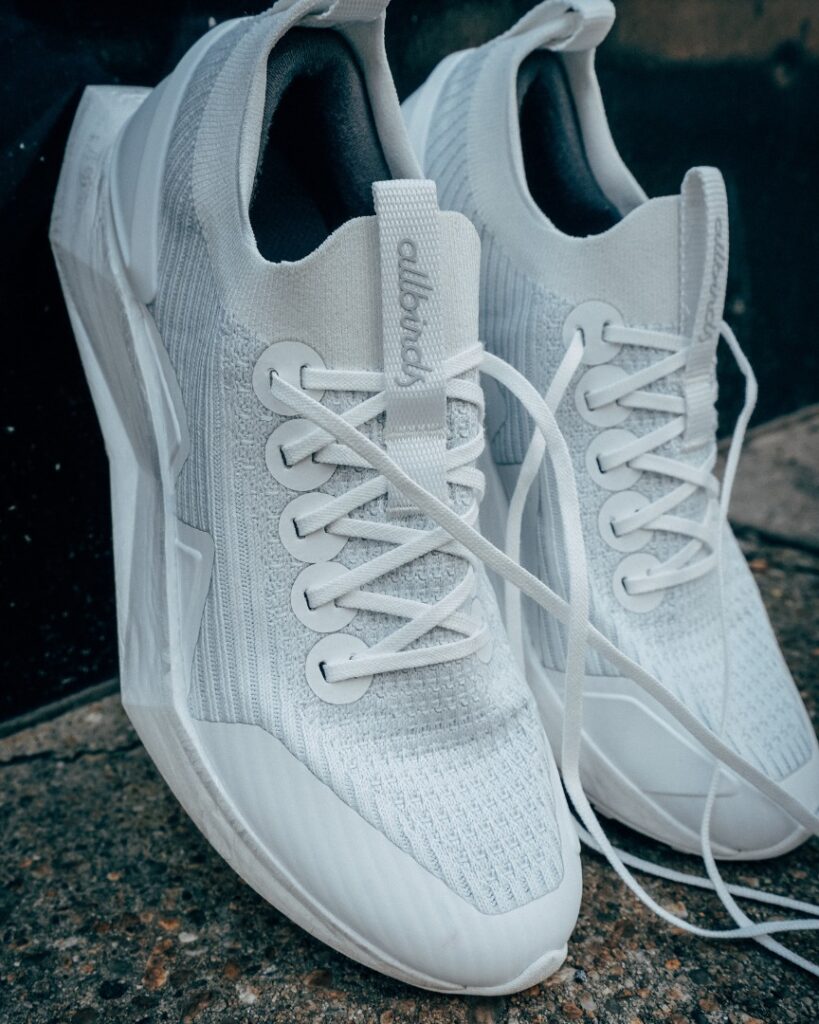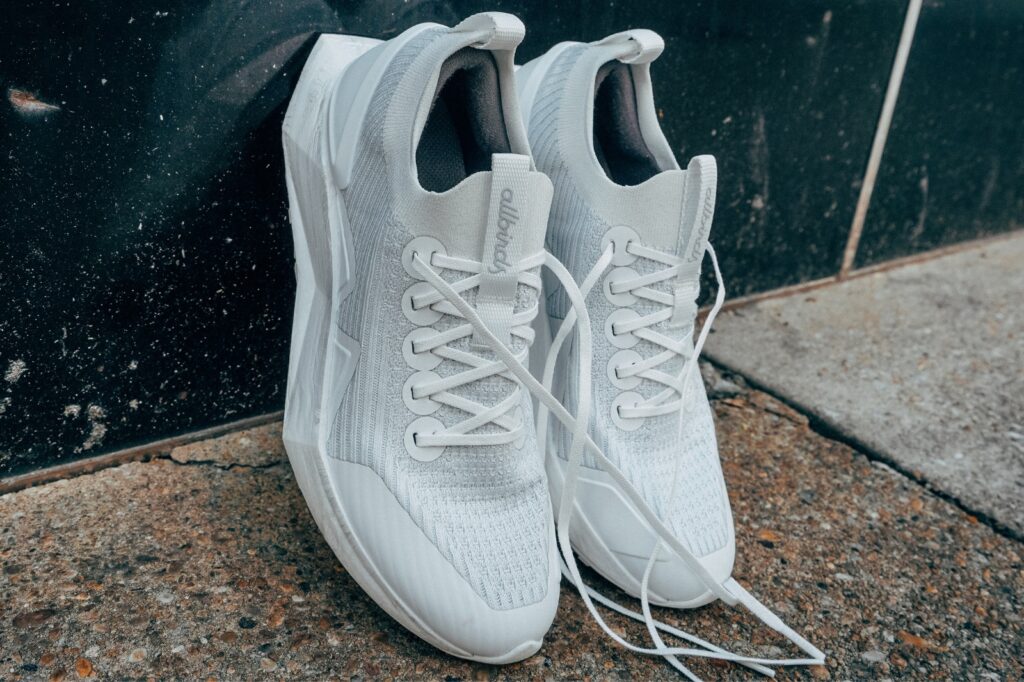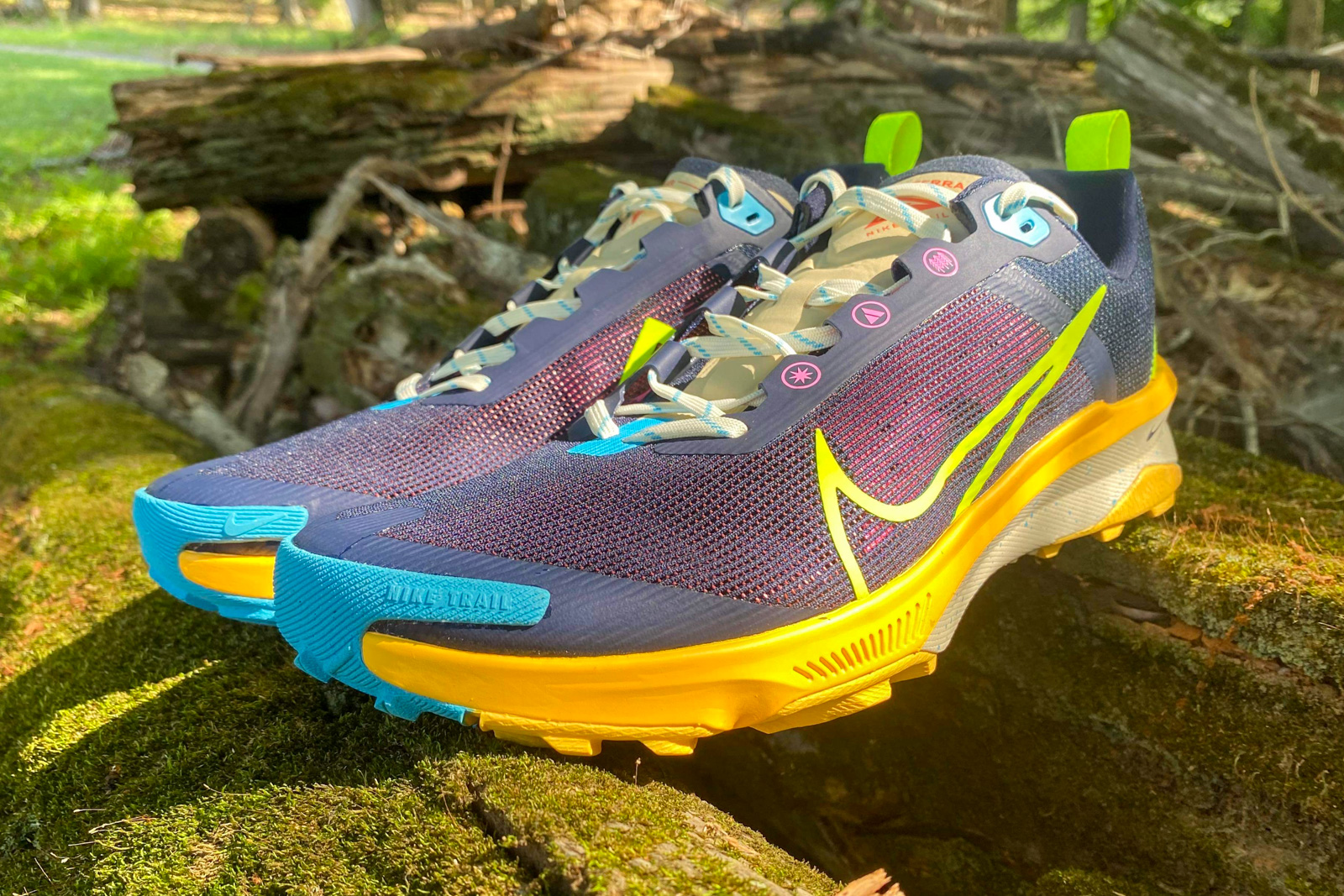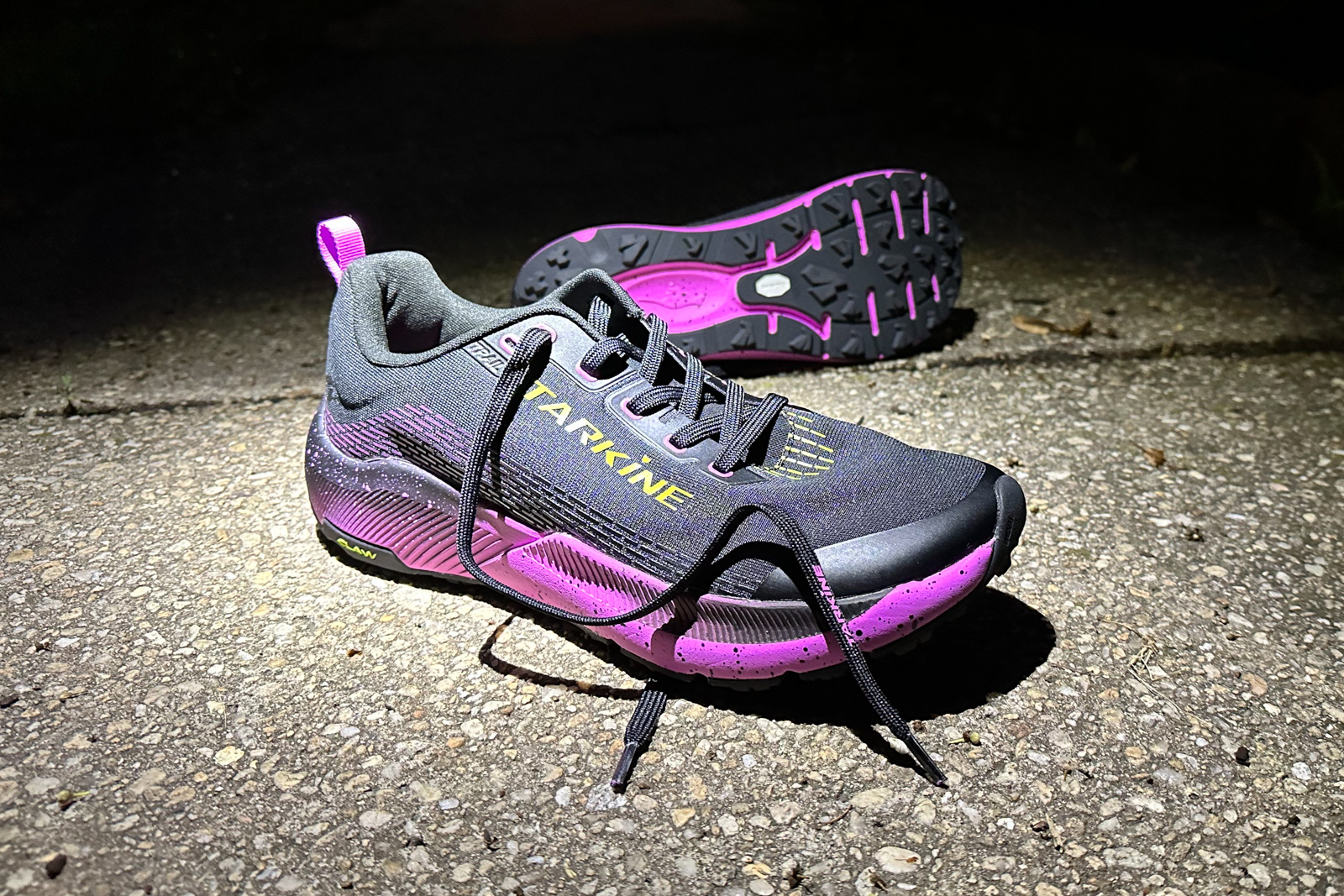
We independently review everything we recommend. When you buy through our links, we may earn a commission.
10.6 oz. (301 g) for a US M9,
8.4 oz. (237 g) for a US W7
31.2 mm in heel, 23.2 mm in forefoot (8 mm drop)
Lifestyle shoe, roads to light trail in the 3-5 mile range
Tencell Lyocell upper, Pebax and castor bean midsole, fairly aggressive rubber outsole, carbon footprint of 7.21 kg CO2e, 2.71 kg less than the last version and barely half of a standard sneaker’s carbon footprint
July 25 for $160
CHAD: As a shoe reviewer, I find that oftentimes I’m playing The Expectations Game, a situation in which your expectations for a shoe often determine which it lands on the positive or negative side of a review.
The higher the expectations, the more likely something is to end up not meeting that high bar and being labeled a disappointment (i.e. the Nike Vaporfly, then everything after). Conversely, the opposite is true when expectations are low; anything that exceeds those expectations is almost guaranteed to be a win (i.e. a lifestyle brand like Nobull creating a viable running shoe is a win, no matter how the shoe compares to already-established running brands). Now entering the Believe in the Run Expectations Game Arena: The Allbirds Tree Flyer 2.
I went into this review with a blank slate. Unlike Robbe, I’ve never run in an Allbirds running-specific shoe (but did try out their SuperLight Trainer). That said, I’m always up to try something new, so I was excited when the Tree Flyer 2 came to my house.
This shoe features a slip-on, booty-style knit upper made from eucalyptus tree fiber, natural rubber outsole with lugs, and Allbirds’ SwiftFoam midsole which is a bio-Pebax made from castor beans. Knowing that Allbirds’ main claim-to-fame was sustainability, I went in with pretty low expectations for how this shoe would perform. How did the Tree Flyer 2 do in the Expectations Game?

Aggressive outsole and toe bumper make this a light trail option
ROBBE: Chad’s not wrong, I review brands like Allbirds with a totally different set of standards than say– Saucony or Brooks. The latter two brands I expect to come correct with an above-average running shoe. When it comes to Allbirds, if I can get some miles in a shoe without hotspots or blisters, it’s probably going to get a good review. This is my fifth time reviewing an Allbirds shoe, and I’m not gonna lie– the first few were pretty terrible, giving me both hotspots and blisters after only a few miles.
But then Allbirds came out with the first version of the Tree Flyer in 2022, and I have to say, I was pleasantly surprised. Was it the best running shoe on the market? Certainly not. But for fans of Allbirds and its simple styling and construction, it was actually a pretty legit running shoe.
As such, I was pretty interested to try the second version of the shoe to see what’s changed, what hasn’t, and if this tree has indeed spread its leaves to provide even more shade on my hot summer runs.
CARYN: My Allbirds Tree Runners are some of my favorite kick-around, go-with-everything casual shoes. While I’m not particularly stylish, I am certainly into simplicity. Despite their very obvious lack of structure and support, my Allbirds are one of my all time favorites for running around all day.
I’ve even worn them to work, which really defies all logic seeing as I’m on my feet for 14 hours at a time. I was certainly intrigued (and yes, quite skeptical) when I was offered the opportunity to review an Allbirds shoe actually designed for running. I had a hard time believing that the minimalist vibe of the Allbird would translate well to functionality on the road.
I do genuinely love the fact that footwear companies are making the effort to minimize their environmental impact, and Allbirds has been there from the beginning. Their take on a Pebax foam is actually made in part from castor beans (wild), and the upper on this particular shoe, the Tree Flyer 2, is made from eucalyptus tree fiber. Let’s see how this bad boy stacks up.
MICHAEL: Before we get into reviewing the latest road runner from the carbon-conscious juggernaut that is all about the birds, I want to clear the air of something: I’m just not that stylish of a runner and definitely not in with the times on what’s hot and what’s not. Sure, I can make an all right pour-over and drive a Subaru to the trail head, so I guess I’m kind of a hipster.
On the flip side though, I still run in old shorts from high school and cotton t-shirts from college. So when it came to background knowledge of the Allbirds lineup– basically the latest and greatest in environmentally conscious lifestyle footwear– I was pretty clueless going into this review. Allbirds’ shoe naming convention only adds perplexity to this; all the models start with a tree, so that’s cool, and then it’s followed by a Dasher/Flyer/Zipper/Runner/Trainer or something like that. We’re only talking about one of those shoes today: the Tree Flyer 2, Allbirds’ latest release in the performance running space.
Allow me to clear up the confusion: the Tree Flyer 2 is Allbirds latest running shoe. Yes, there is a model called the Tree Runner, but I’m not sure that one is really made for running (editor’s note: we did review that shoe as a runner and can confirm that it’s not a runner). The Tree Flyer 2 is for running as we know it here at BITR: mileage, daily training, bonking, ankle-rolling, etc., with all of the futuristic styling and awesome eco-friendly materials we’ve come to expect from Allbirds thrown in.
Unfortunately most of our past reviews conclude with something to the effect of “the materials and mission and looks of this shoe are awesome, and it sort of works for running’ Without spoiling the rest of the review, I really think that sentiment changes with this latest release. There’s a lot of great stuff to talk about here when it comes to performance on the run; not just looks or the carbon footprint.
Shop Allbirds - Men Shop Allbirds - Women
Half the carbon output of the average running shoe

Comfortable upper and good heel lockdown
CHAD: Watch out running shoe world: Allbirds has brought a real winner to the market in the Tree Flyer 2. The step-in feel and comfort of the upper is very nice, with a fit that’s secure but not smothering. I’m on record for not loving one-piece socklike uppers; I feel they lack structure and can cause lace-bite issues. But between an exterior heel counter and strategically placed TPU overlays, this upper provides extra support and avoids the typical pitfalls of sock uppers.
While the comfort of the upper is top notch, the ride is just as good if not better. The traction from the lugs on the outsole is similar to that of your more well-known outsole compounds (Adidas’ Continental rubber, PumaGrip, or Skechers’ Goodyear rubber). Let’s get one thing straight, though: While they call their midsole a bio-Pebax, it does not have the feel of your traditional fossil-fuel Pebax foams. It’s fairly firm, and doesn’t have that rebound or propulsive feel of Nike’s ZoomX, Adidas’ Lightstrike Pro, or Saucony’s PWRRUN PB. Allbirds claims an estimated 70% rebound rate, which is far lower than the typical Pebax brag from other brands. That’s all fine-and-dandy, because I actually prefer a firmer ride in a daily trainer. So kudos for that from me.
Underfoot, the Tree Flyer 2 has surprising stability. Those TPU overlays and the heel counter that provide structure to the upper also provide pretty solid lateral and medial stability, which pairs well with the wide base from heel-to-toe. Plus, I think the shoe looks pretty cool, too, in the all-white colorway. It’s what I imagine a shoe made by Tesla would look like.

ROBBE: Out of the box, I was pretty surprised at how good this shoe looked, because I typically think that, visually, Allbirds sparks as much joy as a collection of office furniture in the Severance HQ. The Tree Flyer 2, however, builds on the Tesla Cybertruck vibes of the first version, offering a clean and angular design that actually has some personality while maintaining the baseline Allbirds DNA.
Looks, of course, mean nothing when it comes to actual running performance, so let’s get into that. The upper is surprisingly well done for a knit upper, which is hit or miss when it comes to running shoes. I actually felt like it was a solid lockdown and pretty comfortable overall.
Underfoot, the shoe isn’t soft or really bouncy, but it’s not bad. I’m actually plenty okay with shoes not being soft and smushy because I feel like running shoes are swinging too far in that direction, so the bio-based midsole worked fine. It’s not Pebax in the traditional sense, though, just know that.
The outsole is pretty aggressive for a road shoe, which is cool, but also a bit weird. It almost looks like a trail shoe, especially with the toe bumper on the front.
Of course, it’s always great when a shoe is sustainable (though that’s a bit of an oxymoron), and truly, nobody does it better than Allbirds (partly why this shoe is $160). From the low carbon footprint to the bio-based materials in the upper and midsole, Allbirds really is doing everything it can to keep it all quiet on the carbon front.
CARYN: While I was initially excited to read about a bio-Pebax foam, I quickly realized that it was nothing like the feel we think of when we think of Pebax. The shoe is extremely firm and not especially responsive, giving off maximum daily trainer vibes. That being said, the step-in feel of the shoe is really nice, and the upper is soft and familiar to my other Allbirds favorites. I don’t mind the firm ride; I think there is a nice place for a firmer shoe in anyone’s rotation, if you just open up your mind beyond the giant marshmallow that the daily trainer market these days.
I also think the firm ride offers some inherent stability, which is not at all what I was expecting based on my more casual Allbirds shoes. The shoe is sleek-looking and edgy (literally, look at the edges), basic, and can easily transition from workout to going out (ok, like, casually).
MICHAEL: The first great note on the Tree Flyer 2 is its unmistakable comfort on step-in. No doubt, this shoe could go toe-to-toe with the most comfortable shoes in the game like the ever-classic Brooks Ghost. The bio-based foam is soft and responsive when walking around in the shoe, and the Tencel upper is soft, breathable, and form-fitting. I’m not sure if Allbirds is planning to sell in specialty run stores, but I think based on looks and step-in comfort they could win over lots of newcomers to the brand.
On the run, the comfort saga continues. Somewhat surprisingly, this upper is one of the best fitting knit uppers I’ve tested. The midfoot tightens down nicely around the arch of the foot, and the added TPU overlays on the sides prevent that pesky stretch-out in the material; a downside all-too-common with knit uppers. The laces; clearly a wool-based concoction, are a pleasant tie, and the upper didn’t get too hot during those humid summer morning runs. Lastly, the heel counter features a nice bit of padding around the Achilles. The entire package here with the upper was very impressive, especially since I’m not typically one to gravitate towards knit.
While I mentioned earlier how comfortable the bio-based midsole is during step-in, on the run it seemed to stiffen significantly. And while the current world of soft foams in daily trainers might suggest this is a bad thing, it’s not necessarily. As Chad said, this shoe has loads of inherent stability; a welcome feature for daily mileage. Additionally, the bio-based outsole compound gives adequate grip on most surfaces, and is one of my favorite features of the Tree Flyer 2.
These outsole lugs have bite; their sharp right angles are ready to grip on light trails or gravel roads. Similar to the Nike Pegasus 40 or Puma Velocity Nitro 2, the Tree Flyer 2 is ready to take on gravel roads, crushed gravel paths, or light trails. Pair that with the protective and supportive midsole, a great fitting upper and a light toe bumper, and the Tree Flyer 2 is just at home on daily runs (and whole foods or oat milk latte runs, because Allbirds) as it is a road-to-trail crusher.
Lastly, I’ll state the obvious: this shoe is eco-friendly as all get-out, and it’s pretty awesome. If you are looking for the ultimate in corporate transparency and eco-friendly design, look no further than Allbirds. Time would fail to talk through all the thoughtful design and creativity put into the sourcing of materials and the construction of this shoe; but just know it’s all interesting and cool. Pair that with the awesome “Tesla” look (thanks Chad) and you have a shoe that’s ready to strike up convos at the Wednesday night group run amidst a sea of Brooks Ghosts and Saucony Rides.
Shop Allbirds - Men Shop Allbirds - Women
CHAD: The shoe, despite the thin knit upper, comes in at 10.6 oz. for a US M9, which is starting to be heavy for a daily trainer. The shoe feels even heavier on the because most of the weight is below the foot, which is something that could add up once the mileage in the run increases.
ROBBE: This isn’t the lightest running shoe in the world. I mean, it’s not even close. And somehow it gained over an ounce of weight over last year’s version. Why? No clue. In fact, it’s one of the heavier daily trainers we’ve reviewed in recent memory, coming in second only to the Adidas Ultraboost. As such, the shoe is a bit clunky on the run.
I know that bio-based and sustainability is Allbirds’ bread and butter, but their midsoles are always going to be subpar in the performance department unless significant innovations are made in the field. Nobody, and I mean nobody– has made a great eco midsole (meaning over 50% of the midsole is made from recycled materials or bio-based materials like castor beans).
The overlays around the toe box probably go further back on the lateral sides than necessary, and cause some rubbing on both pinky toes on each run. I also got a little blistering on my medial arch on my right foot as well, also from the overlay. Nothing insane, but still worth noting.

Allbirds calls out other brands for using “industry-standard Pebax made from 100% fossil fuels and gas,” while touting their “bio-based Pebax” made with sustainably-sourced castor beans. This would almost make you believe the entire midsole is made from castor beans. But what about that Pebax part? The truth is, around half of the midsole is made from that same fossil fuel Pebax that they call out other brands for using (Allbirds doesn’t disclose midsole composition percentages, but in most eco-friendly shoes, the eco part of the midsole is usually around 47% percent which is seemingly the maximum amount allowed without totally sacrificing comfort).
Pebax is Pebax, and those oil-based midsoles are soft and bouncy and provide incredible performance. There’s a reason every single premium race-day shoe uses full Pebax. On the other hand, castor beans are eco-friendly and sustainable but are firm and dead and feel like sh*t on the run (just ask Veja, who tried to do a 62% bio-based midsole and made one of the worst midsoles we ever tested in the Marlin).
All I’m trying to say is that while I applaud Allbirds use of bio-based materials in the midsole, even if you blend them with Pebax, they’re just still below average when it comes to performance. However, I do think they pull it off better than anyone else, and it’s significantly better than midsoles from other eco-conscious brands like Veja. Nevertheless, you’re still using oil-based materials, because nobody can make a running shoe without them.
The upper, while comfortable and well-fitting, is pretty warm. I’d probably save these as non-summer running shoes.
At $160, there’s about 53 shoes you can buy that are as good or better than the Tree Flyer 2. None of them will be as eco-friendly, but if you’re a “let the world burn” type of person, then you should just go with one of those. The truth is, it costs a lot of money to mine all those eco materials and bring them together. If you do care about the environment and sustainability in your footwear, at the end of the day, you’re gonna have to put your money where your mouth is.
CARYN: This shoe was definitely a bit clunky for me overall. It also ran on the small side, making it tougher than usual for me to get a good feel for the shoe. The firm ride made it a little slappy (my favorite scientific term), and it definitely lacks the flexibility that would make it a more responsive, fun ride.
This is definitely a shoe for easy miles, because I really couldn’t get past the weight of the shoe to try and pick the pace up at all. I would personally stick with this shoe for shorter runs, because the bootie fit and subsequent lack of lockdown had me adjusting it frequently (but to be honest, I’ve never been a fan of bootie fit shoes, so color me biased).
MICHAEL: Like Chad said, this shoe is heavy. And while the weight isn’t a deal-breaker for the shoe, it does make it more of a tree cruiser and not a Tree Flyer. Between the firm midsole and the weight, I found this shoe to be comfortable for easy paces for 4-5 mile runs.
Sometimes, in heavier shoes with responsive midsole foams, the bounce of the midsole helps to counteract the weight of the shoe, like in the Saucony Triumph. Unfortunately, it’s the weight of the Tree Flyer 2 that’s doing the overcoming of the midsole bounce. Again, this wasn’t a horrible feeling, it just limits the shoe’s versatility. It’s still going to be a great option for turning heads at the group run and moderately protective for road-to-trail use.
Additionally, I’m not sure how well the bio-based midsole will last as its texture reminds me somewhat of a bouncy styrofoam. That being said, it is already firm, so maybe as the mileage ticks on the difference in responsiveness will be negligible.
Shop Allbirds - Men Shop Allbirds - WomenCHAD: In this episode of the Expectations Game, I would deem the Allbirds Tree Flyer 2 a big winner. I went in with low expectations, anticipating that I would churn out my miles for review and be done with it. However, I am intrigued to see what Allbirds’ bio-PEBAX midsole feels like after being given a chance to fully break-in, which probably could take 30-50 miles.
I could easily see myself pulling this off the shelf for some of my shorter midweek runs during my marathon training cycle this fall. Plus, the fact that this shoe has a carbon footprint of 7.21 CO2e, which is about half of what a “normal” sneaker has, makes it a winner when it comes to sustainability and the environment. That right there would make it a winner in my book.

ROBBE: I thought this was a pretty good attempt at a solid running shoe from Allbirds, and if you are an Allbirds fan looking for a shoe that can handle 3-5 miles a few times a week, then I don’t think you’re going to be disappointed. That said, as the only reviewer who’s tried the first version of this shoe, I’m not sure I see many improvements over the last version. If anything, it may be a step back from the original Tree Flyer (though it is better design-wise).
So while this is a solid attempt at a sustainable running shoe, I’d pick up one of last year’s pairs before they end up in a shredder or a landfill.
CARYN: Not bad, Allbirds. Definitely more impressive than I imagined, seeing as you could actually run in this shoe without wanting to stop after the first 800m (you can tell my expectations were… low). Jokes aside, this shoe is both functional and comfortable for shorter runs. While this shoe won’t challenge some of the giants in the daily trainer market right now, I can certainly see some folks really enjoying it.
The stable ride and stylistic versatility makes it a decent pick, especially if environmental consciousness is any part of the decision-making process. So get out there, snag a pair, jump in your electric car and tackle those weeds in your community garden. You’ll certainly look good doing it.
MICHAEL: While Allbirds goals with the Tree Flyer 2 are probably different than the ones I formulate on their behalf up in my own brain, I think a truly successful performance shoe launch for Allbirds is one that challenges the established players in the ‘intro to running’ game. I’m talking about best-sellers like the Hoka Clifton, Nike Pegasus 40, and Brooks Ghosts.
To be fair, you can create the most eco-friendly running shoe in the world, but if no one swaps over from a non-eco-friendly option and buys the product, it’s not going to have widespread influence in the market. While these perennial bestsellers will no doubt likely make up for most of the sales at local running stores, Allbirds has a really great thing going in the Tree Flyer 2– it’s a serious contender that’s poised to win over some with its excellent styling, solid fit, and versatile midsole and outsole.
I’m here to say Allbirds have a legit running shoe in its historically lifestyle-oriented lineup, and if you’re looking for an eco-friendly, carbon-conscious alternative to any of the shoes mentioned above, the Tree Flyer 2 warrants attention.
You can pick up the Allbirds Tree Flyer 2 on July 25 for $160 by using the shop links below.
Have something to say? Leave a Comment

An attorney by day, Chad lives in Central Pennsylvania with his wife and three kids. Never much for running growing up, Chad began running as a way to improve his physical health. He went from his first 5k in 2015 to running the Paris Marathon in 2016. Given his larger physical build, Chad is the resident Clydesdale runner, providing shoe and gear insights for those with a bigger build and taller stature.
More from Chad
Robbe is the senior editor of Believe in the Run. He loves going on weird routes through Baltimore, finding trash on the ground, and running with the Faster Bastards. At home in the city, but country at heart. Loves his two boys more than anything. Has the weakest ankles in the game.
More from Robbe
Caryn is a recovering ball sports athlete and native Baltimorean who used to cry before the timed mile in gym class. Discovered running somewhat reluctantly when her pants stopped fitting in college, now a big fan of the marathon– go figure! Pediatric ICU nurse and avid UVA sports fan. Can usually be found with her chocolate lab, Gus, looking for a good cup of coffee.
More from Caryn
An engineer living with his wife and cat in Birmingham, Ala., Michael loves chill morning runs in the neighborhood, but especially enjoys soaking up long miles of technical southeast singletrack. Occasionally, he’ll get a racing itch and actually string together some “organized” training for a trail race or FKT. In his free time, Michael enjoys books, backpacking, and hanging out with friends.
More from Michael
